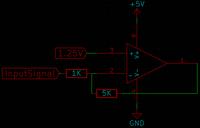Sharagim
Advanced Member level 4
Hi,
Is there any possibility to use single supply OPAMP (rail-to-rail) to amplify 10-100mv signal? or for such a small range we have to use Dual Supply!
Is there any possibility to use single supply OPAMP (rail-to-rail) to amplify 10-100mv signal? or for such a small range we have to use Dual Supply!

